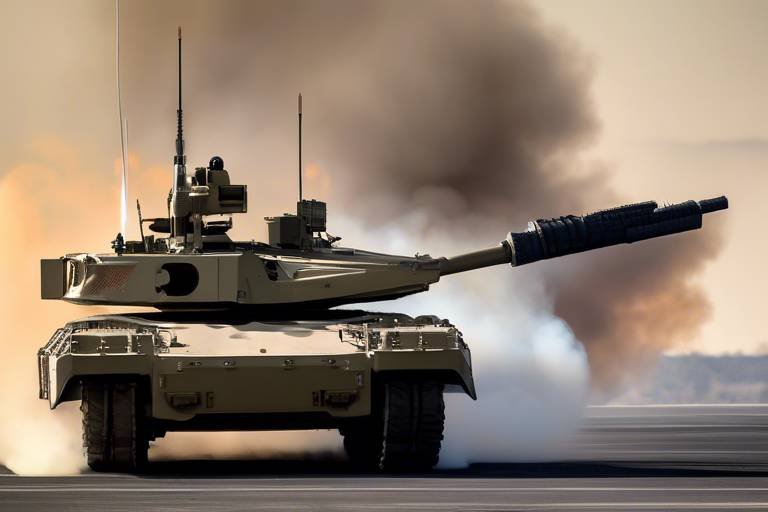Analyzing the Effectiveness of Electronic Warfare Systems
In today's rapidly evolving battlefield, electronic warfare (EW) systems have emerged as pivotal tools that can significantly alter the tide of military engagements. These systems represent a blend of technology and strategy, designed to exploit the vulnerabilities of enemy electronic capabilities while protecting one's own. But how effective are these systems in real-world scenarios? This article aims to peel back the layers of electronic warfare, examining its capabilities, challenges, and the profound impact it has on modern military operations and strategies.
To truly understand the effectiveness of electronic warfare systems, we first need to appreciate the broader context in which they operate. Electronic warfare is not just about jamming signals or disrupting communications; it's about gaining a strategic advantage that can mean the difference between victory and defeat. The ability to disrupt enemy communications, deceive surveillance systems, and protect friendly assets is a game-changer in military operations.
At its core, electronic warfare encompasses a variety of techniques that can be broadly categorized into three main types: electronic attack, electronic protection, and electronic support. Each of these categories plays a unique role in military strategy, and their effectiveness can vary based on the context in which they are employed. For instance, consider a scenario where a military unit is advancing into enemy territory; effective electronic attack measures can blind the enemy's radar systems, allowing for safer troop movements.
However, the effectiveness of electronic warfare systems is not without its challenges. As technology advances, so too do the countermeasures employed by adversaries. This cat-and-mouse game of technological innovation means that military forces must continuously adapt and evolve their electronic warfare strategies. Moreover, there are legal and ethical implications to consider, especially regarding the potential for collateral damage and the impact on civilian infrastructure.
Real-world case studies provide a wealth of information regarding the effectiveness of electronic warfare systems. For example, during the Gulf War, the U.S. military effectively utilized electronic warfare to disrupt Iraqi communications and radar systems, leading to significant operational advantages. Yet, not all instances have been as successful. The lessons learned from these conflicts highlight the importance of adapting strategies to meet the unique challenges presented by each situation.
As we look towards the future, the landscape of electronic warfare is poised for transformation. Emerging technologies, such as artificial intelligence and advanced cyber capabilities, are set to redefine how electronic warfare systems operate. These innovations promise to enhance the effectiveness of electronic warfare, but they also raise new questions about the nature of warfare itself. Will future conflicts be fought in the electromagnetic spectrum as much as on the ground or in the air?
In summary, electronic warfare systems are a crucial component of modern military strategy, offering both offensive and defensive capabilities that can significantly influence the outcome of conflicts. Their effectiveness hinges not only on technological superiority but also on the ability to adapt to an ever-changing battlefield. As we continue to explore the dimensions of electronic warfare, it becomes clear that understanding its complexities is essential for any military force seeking to maintain a strategic edge.
- What is electronic warfare?
Electronic warfare refers to military actions that use electromagnetic energy to control the electromagnetic spectrum or to attack the enemy.
- How does electronic warfare impact modern military operations?
It enhances operational effectiveness by disrupting enemy communications and protecting friendly forces from similar attacks.
- What are the main types of electronic warfare?
The three main types are electronic attack, electronic protection, and electronic support.
- What challenges does electronic warfare face?
Challenges include rapid technological advancements by adversaries, legal implications, and the need for constant adaptation of strategies.
Understanding Electronic Warfare
Electronic warfare (EW) is a fascinating and complex domain within military operations, fundamentally altering how conflicts are fought in the modern age. At its core, electronic warfare involves the use of electromagnetic energy to manipulate or disrupt enemy electronic systems, creating a significant advantage on the battlefield. Think of it as a digital chess game where each move can either fortify your position or expose you to vulnerabilities. The stakes are high, and understanding the nuances of electronic warfare is crucial for any military strategist.
To better grasp what electronic warfare entails, it's essential to break it down into its fundamental components. There are three primary categories of electronic warfare: electronic attack, electronic protection, and electronic support. Each of these plays a distinct yet interconnected role in military strategy:
- Electronic Attack: This involves offensive actions aimed at disrupting or destroying enemy electronic systems. Techniques include jamming, which blocks communications, and spoofing, which misleads enemy systems.
- Electronic Protection: This focuses on safeguarding friendly systems from electronic threats, ensuring that one's own operations remain unaffected by enemy actions.
- Electronic Support: This entails gathering intelligence and providing situational awareness through the monitoring of enemy electronic emissions.
Historically, electronic warfare has roots that stretch back to World War II, when the first instances of radar jamming were employed. As technology has advanced, so too has the complexity of electronic warfare systems. Today, these systems integrate sophisticated algorithms and artificial intelligence, enabling real-time decision-making and rapid responses to evolving threats.
The evolution of electronic warfare has been nothing short of revolutionary. In the past, military forces relied heavily on physical combat and conventional strategies. However, with the advent of advanced technology, such as drones and cyber capabilities, the battlefield has transformed into a multi-dimensional arena where electronic warfare can tip the scales of victory. It’s akin to upgrading from a manual typewriter to a high-speed computer; the speed and efficiency of operations are dramatically enhanced.
Moreover, the integration of electronic warfare into military operations is not merely about having superior technology; it’s also about understanding the strategic implications of using such capabilities. The ability to disrupt enemy communications can provide a tactical edge, but it also raises questions about the ethical and legal ramifications of such actions. As we navigate this complex landscape, military leaders must weigh the potential benefits against the risks of escalation and unintended consequences.
In conclusion, understanding electronic warfare is vital for comprehending modern military strategies. As warfare continues to evolve, so will the tactics and technologies employed in electronic warfare. The future promises even more sophisticated systems that will challenge our understanding of conflict and defense. Staying ahead in this arena requires not just technological advancements but also a deep understanding of the principles that govern electronic warfare.
What is electronic warfare?
Electronic warfare refers to military actions that use electromagnetic energy to disrupt or deceive enemy electronic systems, providing a tactical advantage.
What are the main types of electronic warfare?
The main types include electronic attack, electronic protection, and electronic support, each serving distinct roles in military strategy.
How has electronic warfare evolved over time?
Electronic warfare has evolved from basic radar jamming in World War II to sophisticated systems that integrate artificial intelligence and real-time decision-making capabilities.
What are the ethical implications of electronic warfare?
The use of electronic warfare raises ethical questions regarding the potential for escalation, unintended consequences, and the impact on civilian infrastructure.
Key Components of Electronic Warfare Systems
When we dive into the world of electronic warfare (EW), it’s crucial to understand the key components that make these systems tick. At the heart of electronic warfare are three main elements: sensors, jammers, and communication systems. Each plays a vital role in the overarching strategy of military operations, working together like the gears of a finely-tuned machine.
Sensors are the eyes and ears of electronic warfare. They detect and analyze enemy electronic signals, providing critical information that can be used to formulate a response. Think of them as the scouts on a battlefield, gathering intel on enemy movements and strategies. The data collected by sensors is invaluable, allowing military forces to understand the battlefield's electronic landscape. This information can be anything from radar signals to communications between enemy units.
Next up, we have jammers. These are the offensive tools of electronic warfare, designed to disrupt or deny the use of enemy electronic systems. Imagine a loudspeaker blasting noise in a quiet library; that’s what jammers do to enemy communications. They can create a fog of confusion, making it nearly impossible for the enemy to coordinate their actions effectively. Jamming can take various forms, including noise jamming, which floods the target frequency with static, or deceptive jamming, which tricks the enemy into believing they are receiving accurate information when, in fact, they are not.
The last critical component is communication systems. While jammers disrupt enemy communications, friendly communication systems ensure that our forces remain connected and coordinated. These systems are essential for maintaining operational integrity and ensuring that commands are executed flawlessly. They can include secure radios, satellite communication links, and other technologies that allow for real-time data sharing among units. Without these communication systems, even the most sophisticated electronic warfare strategies would fall apart.
| Component | Function | Importance |
|---|---|---|
| Sensors | Detect and analyze enemy signals | Provide critical battlefield intelligence |
| Jammers | Disrupt enemy communications | Create confusion and hinder enemy coordination |
| Communication Systems | Facilitate secure communication among friendly forces | Ensure operational integrity and command execution |
In summary, the synergy between sensors, jammers, and communication systems forms the backbone of electronic warfare strategies. Each component is like a piece of a puzzle, and when put together, they create a comprehensive approach to modern military operations. Understanding these key components is essential for grasping how electronic warfare can influence the outcome of conflicts.
- What is electronic warfare? Electronic warfare refers to military actions that use electromagnetic energy to control the electromagnetic spectrum or to attack the enemy.
- How do jammers work? Jammers disrupt enemy communications by flooding the frequency with noise or sending false signals.
- Why are sensors important in electronic warfare? Sensors provide critical information about enemy signals, helping to inform tactical decisions.
- What role do communication systems play? Communication systems ensure that friendly forces can coordinate effectively, even amid electronic attacks.
Types of Electronic Warfare
When we dive into the realm of electronic warfare (EW), it’s essential to understand that it’s not a one-size-fits-all approach. Instead, it comprises several distinct types, each designed to serve specific roles within military strategy. Broadly speaking, electronic warfare can be categorized into three primary types: Electronic Attack, Electronic Protection, and Electronic Support. Each type plays a crucial role in enhancing military effectiveness and ensuring operational success.
Electronic Attack (EA) is the offensive arm of electronic warfare. It involves actions taken to disrupt, degrade, or destroy enemy electronic systems. Think of it like a digital assault, where military forces use various techniques to blind or confuse the adversary. Techniques such as jamming, where signals are overwhelmed with noise, and spoofing, which misleads enemy systems into believing they are receiving legitimate signals, are prime examples of EA in action. In modern warfare, the ability to execute effective electronic attacks can turn the tide of battle by crippling an enemy's communication and surveillance capabilities.
On the flip side, we have Electronic Protection (EP). This type focuses on safeguarding friendly electronic systems from enemy attacks. Imagine it as a digital shield, designed to ensure that your forces can communicate and coordinate effectively, even in the face of enemy interference. Strategies for electronic protection often include encryption, frequency hopping, and the use of redundant systems that can operate even if one part is compromised. By implementing robust electronic protection measures, military operations can maintain their operational integrity and continue functioning despite adversarial efforts to disrupt them.
Lastly, there’s Electronic Support (ES), which is all about gathering intelligence. This type involves the use of electronic means to detect, intercept, and analyze enemy signals. It’s like having a pair of digital ears and eyes that can pick up on the enemy’s communications and movements. The information gathered through electronic support can be invaluable for strategic planning and decision-making. Whether it’s identifying enemy positions or monitoring their electronic activities, effective electronic support provides a tactical advantage that can be pivotal in military operations.
In summary, the three types of electronic warfare—Electronic Attack, Electronic Protection, and Electronic Support—are interconnected and vital to modern military operations. Each type plays a distinct role, contributing to a comprehensive electronic warfare strategy that enhances operational effectiveness and ensures that military forces can navigate the complexities of the modern battlefield.
- What is the primary purpose of electronic warfare? Electronic warfare aims to disrupt or deceive enemy electronic systems while protecting friendly systems from similar attacks.
- How does electronic attack differ from electronic protection? Electronic attack focuses on offensive measures to disrupt enemy systems, whereas electronic protection aims to safeguard friendly systems from attacks.
- Can electronic warfare be used in non-military contexts? Yes, electronic warfare techniques can also be applied in cybersecurity and information warfare to protect data and networks.
Electronic Attack Techniques
Electronic attack is a crucial aspect of modern warfare, serving as a powerful tool for disrupting enemy operations through various offensive measures. At its core, electronic attack seeks to incapacitate or deceive adversary electronic systems, creating a tactical advantage on the battlefield. Imagine a chess game where your opponent's pieces suddenly stop responding to commands; that’s the essence of what electronic attack aims to achieve in military contexts.
Among the most commonly employed techniques in electronic attack are jamming and spoofing. Jamming involves overwhelming enemy communication channels with noise or false signals, rendering their systems ineffective. Think of it as trying to have a conversation in a crowded room where everyone is shouting at the top of their lungs. In contrast, spoofing refers to the act of deceiving enemy systems by mimicking legitimate signals, leading them to believe they are interacting with friendly units when, in reality, they are not. This technique can be likened to a magician pulling off a sleight of hand, diverting attention away from the truth.
To illustrate the effectiveness of electronic attack techniques, let's look at a few real-world applications:
| Technique | Description | Real-World Example |
|---|---|---|
| Jamming | Overloading enemy communications with noise | Operation Desert Storm |
| Spoofing | Deceiving enemy systems with false signals | Various cyber operations |
| Cyber Attacks | Targeting enemy networks to disrupt operations | Stuxnet Worm Incident |
These techniques have been shown to significantly alter the course of engagements. For example, during Operation Desert Storm, coalition forces effectively utilized jamming to disrupt Iraqi radar systems, allowing for unhindered air operations. Similarly, the infamous Stuxnet worm demonstrated the potential of cyber attacks to cripple enemy infrastructure without a single shot being fired.
However, it’s essential to acknowledge that while electronic attack techniques can provide a formidable edge, they also come with challenges. The rapid advancement of technology means that adversaries are continuously developing countermeasures to mitigate the effects of electronic attacks. This ongoing cat-and-mouse game requires military strategists to remain vigilant and innovative, always looking for new ways to outsmart the enemy.
In conclusion, electronic attack techniques are indispensable in the arsenal of modern military operations. They not only enhance tactical capabilities but also reshape the dynamics of warfare. As we continue to explore the evolving landscape of electronic warfare, it becomes increasingly clear that those who master these techniques will hold the keys to future conflicts.
- What is electronic warfare? Electronic warfare involves using electromagnetic spectrum capabilities to disrupt or deceive enemy operations.
- What are the main types of electronic attack? The primary types include jamming, spoofing, and cyber attacks.
- How effective are electronic attack techniques? They can significantly disrupt enemy operations, as evidenced by historical military engagements.
- What challenges do electronic attacks face? Adversaries are constantly developing countermeasures, requiring ongoing adaptation and innovation.
Electronic Protection Strategies
In the ever-evolving landscape of military operations, electronic protection has become a crucial element in safeguarding friendly systems from enemy electronic attacks. As the battlefield becomes increasingly digitized, the need for robust electronic protection strategies has never been more pressing. These strategies are designed to enhance the resilience of military assets, ensuring that they can operate effectively even in the face of sophisticated electronic threats.
At its core, electronic protection involves a combination of techniques and technologies aimed at shielding communication systems, sensors, and weaponry from being disrupted or compromised. Think of it as a digital fortress, where each layer of defense is meticulously crafted to thwart potential intrusions. One of the primary methods employed in electronic protection is signal encryption. By encoding sensitive information, military forces can prevent adversaries from intercepting and deciphering critical communications.
Another essential aspect of electronic protection is redundancy. Just as a backup generator ensures that power is available during an outage, redundant systems provide alternative pathways for communication and data transfer. This means that if one system is compromised, others can seamlessly take over, maintaining operational continuity. For instance, military aircraft often employ multiple communication channels to ensure that pilots can maintain contact with ground control, even if one channel is jammed or disrupted.
Moreover, frequency hopping is a fascinating technique used in electronic protection. This method involves rapidly switching the frequency of communication signals, making it difficult for adversaries to lock onto and jam these signals. Imagine trying to catch a fish that keeps darting in different directions; that’s what electronic warfare opponents face when dealing with frequency-hopping systems. By constantly changing frequencies, military forces can maintain a secure line of communication, even in hostile environments.
In addition to these techniques, training and awareness play a vital role in electronic protection strategies. Personnel must be well-versed in recognizing and responding to electronic threats. Regular drills and simulations can help ensure that military operators are prepared to react swiftly to potential electronic attacks. This proactive approach can mean the difference between mission success and failure.
Furthermore, collaboration with cybersecurity experts has become essential in developing comprehensive electronic protection strategies. As the lines between electronic warfare and cyber warfare blur, military forces must leverage the expertise of cybersecurity professionals to fortify their defenses. This collaboration can lead to the development of advanced algorithms and systems designed to detect and mitigate threats in real-time.
To illustrate the effectiveness of these strategies, consider the following table that outlines some common electronic protection techniques and their benefits:
| Technique | Description | Benefits |
|---|---|---|
| Signal Encryption | Encoding communications to prevent interception | Secures sensitive information |
| Redundancy | Using multiple systems for communication | Ensures operational continuity |
| Frequency Hopping | Rapidly changing communication frequencies | Difficult for adversaries to jam |
| Training & Awareness | Regular drills and education on electronic threats | Prepares personnel for quick responses |
| Cybersecurity Collaboration | Working with experts to enhance defenses | Develops advanced threat detection systems |
In conclusion, electronic protection strategies are not just about technology; they encompass a holistic approach that includes training, redundancy, and collaboration. As the landscape of warfare continues to change, military forces must remain agile and adaptable, ensuring that their electronic systems are fortified against an array of threats. The stakes are high, and the cost of failure can be catastrophic, making effective electronic protection an indispensable component of modern military operations.
- What is electronic protection? Electronic protection refers to the strategies and techniques used to safeguard military systems from electronic attacks.
- Why is redundancy important in electronic protection? Redundancy ensures that if one system fails or is compromised, alternative systems can maintain operations, preventing mission failure.
- How does frequency hopping work? Frequency hopping involves rapidly changing communication frequencies to make it difficult for adversaries to jam signals.
- What role does training play in electronic protection? Training prepares military personnel to recognize and respond to electronic threats effectively, enhancing overall mission success.
- Why collaborate with cybersecurity experts? Collaboration with cybersecurity experts helps develop advanced defenses against both electronic and cyber threats, ensuring comprehensive protection.
Challenges in Electronic Warfare
Electronic warfare (EW) has revolutionized military operations, but it doesn't come without its fair share of challenges. As technology advances, so do the complexities associated with deploying effective electronic warfare systems. One of the primary challenges is the rapid pace of technological advancements. New communication systems, sensors, and countermeasures are constantly being developed, making it difficult for military forces to keep up. For instance, while a particular jamming technique may be effective today, tomorrow's adversaries might deploy sophisticated countermeasures that render it obsolete.
Moreover, the legal implications surrounding electronic warfare present another significant hurdle. The use of electronic attacks can often blur the lines between warfare and peacetime activities, raising questions about legality and ethics. These concerns are particularly pronounced when civilian infrastructure could be affected, as the unintended consequences of electronic warfare can lead to collateral damage, which is a nightmare scenario for any military strategist.
Additionally, interoperability between different electronic warfare systems poses a challenge. In joint operations, various military branches and allied nations must be able to communicate and share information effectively. However, differing technologies and operational procedures can lead to gaps in coordination. For example, if one unit employs a specific electronic attack that another unit is unaware of, it could inadvertently disrupt their operations, leading to confusion and potential mission failure.
Another challenge is the resource allocation for electronic warfare capabilities. Developing, maintaining, and upgrading EW systems can be resource-intensive. Military budgets are often stretched thin, and prioritizing electronic warfare capabilities over other critical areas can be a tough decision. This situation is further complicated by the need for ongoing training and education for personnel to effectively operate these advanced systems.
Lastly, the psychological aspect of electronic warfare shouldn't be underestimated. The mere threat of an electronic attack can create a sense of uncertainty and fear among adversaries. However, this psychological edge can be diminished if the enemy develops their own countermeasures or becomes desensitized to the threat. Therefore, maintaining a strategic advantage requires constant innovation and adaptation, which can be a daunting task.
In summary, while electronic warfare offers significant advantages in modern military operations, it also presents a unique set of challenges. From technological advancements and legal implications to interoperability issues and resource allocation, military strategists must navigate a complex landscape to ensure the effectiveness of their electronic warfare systems.
- What is electronic warfare? Electronic warfare refers to military operations that use electromagnetic energy to control the electromagnetic spectrum or to attack the enemy.
- What are the main types of electronic warfare? The main types include electronic attack, electronic protection, and electronic support.
- What challenges does electronic warfare face? Challenges include technological advancements, legal implications, interoperability issues, resource allocation, and psychological factors.
- How does electronic warfare impact modern military strategies? Electronic warfare enhances operational effectiveness by disrupting enemy communications and protecting friendly forces.
Case Studies of Electronic Warfare in Action
Analyzing real-world examples of electronic warfare provides us with invaluable insights into its effectiveness and the lessons learned from various conflicts. One of the most notable instances occurred during the Gulf War in the early 1990s, where the United States employed sophisticated electronic warfare systems to gain a decisive advantage over Iraqi forces. The operation showcased how electronic jamming and deception tactics could significantly disrupt enemy communications and radar systems, leading to a swift and effective military campaign.
Another compelling case is the Russia-Georgia War in 2008. During this conflict, both sides utilized electronic warfare techniques, but Russia's capabilities were particularly noteworthy. They deployed jammers that effectively blinded Georgian radar systems, making it difficult for them to coordinate their defenses. This incident highlights the importance of understanding adversaries' electronic capabilities and the need for robust electronic protection strategies to counter such threats.
To further illustrate the impact of electronic warfare, we can examine the following table, which summarizes key electronic warfare operations from these conflicts:
| Conflict | Year | Key Electronic Warfare Tactics | Outcome |
|---|---|---|---|
| Gulf War | 1991 | Jamming, Deception | Decisive U.S. Victory |
| Russia-Georgia War | 2008 | Jamming, Signal Interception | Russian Advantage |
These case studies not only highlight the effectiveness of electronic warfare but also underscore the need for continuous innovation in military strategies. The rapid advancement of technology means that adversaries are constantly evolving their tactics, making it essential for military forces to stay ahead of the curve. In this ever-changing landscape, the integration of artificial intelligence and cyber capabilities is becoming increasingly vital for enhancing electronic warfare operations.
As we reflect on these historical examples, it’s clear that the lessons learned can inform current and future military strategies. For instance, the importance of interoperability between electronic and conventional warfare systems cannot be overstated. Military planners must ensure that their forces are equipped to handle the complexities of modern electronic warfare, which often involves a combination of offensive and defensive measures.
In conclusion, the case studies of electronic warfare in action reveal a complex interplay of tactics and technologies that can significantly influence the outcomes of military engagements. Understanding these dynamics is crucial for developing effective strategies that can adapt to the challenges posed by modern conflicts.
- What is electronic warfare? - Electronic warfare refers to the use of electromagnetic spectrum to disrupt or deceive enemy electronic systems.
- How does electronic warfare impact military operations? - It can significantly enhance operational effectiveness by disrupting enemy communications and radar, providing a tactical advantage.
- What are the main types of electronic warfare? - The main types include electronic attack, electronic protection, and electronic support, each serving distinct roles in military strategy.
- Can electronic warfare be countered? - Yes, adversaries can develop countermeasures, which is why continuous innovation and adaptation are necessary in electronic warfare tactics.
Lessons Learned from Historical Conflicts
Throughout history, electronic warfare has played a pivotal role in shaping the outcomes of various military conflicts. One of the most significant lessons learned is the importance of adaptability. As technology evolves, so too do the tactics employed by both friendly and enemy forces. For instance, during the Gulf War in the early 1990s, the United States utilized advanced electronic warfare systems to achieve air superiority. However, this success was not solely due to technology; it also stemmed from the ability to adapt strategies in real-time based on the enemy's responses.
Another critical takeaway is the necessity of interoperability among allied forces. Historical conflicts have demonstrated that when different military branches or allied nations operate with incompatible systems, the effectiveness of electronic warfare diminishes. For example, during NATO operations, the integration of various electronic warfare assets from different countries often led to communication breakdowns and reduced operational efficiency. Therefore, investing in systems that can communicate seamlessly is essential for future military success.
Moreover, the significance of intelligence gathering cannot be overstated. Effective electronic warfare relies heavily on accurate and timely intelligence. Lessons from conflicts like the Vietnam War highlighted how inadequate intelligence could lead to catastrophic failures in electronic attack missions. In contrast, successful operations, such as those seen in the Kosovo War, showcased how robust intelligence capabilities could enhance the effectiveness of electronic countermeasures.
As we analyze these historical examples, it becomes evident that training and education for personnel involved in electronic warfare is crucial. The knowledge and skills of operators can significantly influence the outcome of electronic engagements. Military organizations must prioritize ongoing training programs that keep personnel updated on the latest technologies and tactics. A well-trained team can leverage electronic warfare systems to their fullest potential, turning the tide of conflict in their favor.
In conclusion, the lessons learned from historical conflicts underscore the necessity of adaptability, interoperability, intelligence gathering, and rigorous training in electronic warfare. As military strategies continue to evolve, these lessons will remain relevant, guiding future operations and ensuring that armed forces are prepared to face the challenges of modern warfare.
- What is electronic warfare? Electronic warfare refers to the use of electromagnetic energy to disrupt or deceive enemy electronic systems.
- What are the main types of electronic warfare? The three main types are electronic attack, electronic protection, and electronic support.
- How does electronic warfare impact military operations? It enhances operational effectiveness by disrupting enemy communications and protecting friendly forces from electronic threats.
- What are some historical examples of electronic warfare? Notable examples include the Gulf War and the Kosovo War, where electronic warfare played a significant role in military success.
Future Trends in Electronic Warfare
As we look ahead, the landscape of electronic warfare is rapidly evolving, driven by advancements in technology and the increasing complexity of modern military operations. One of the most significant trends is the integration of artificial intelligence (AI) into electronic warfare systems. AI has the potential to enhance decision-making processes, allowing for quicker responses to electronic threats. Imagine a system that learns from previous engagements and adapts its strategies in real-time—this is not science fiction; it's becoming a reality.
Moreover, the rise of cyber capabilities is transforming the battlefield. Cyber warfare and electronic warfare are becoming increasingly intertwined, with adversaries leveraging both domains to gain the upper hand. This convergence means that military planners must consider cyber vulnerabilities when developing electronic warfare strategies. For instance, a well-coordinated cyber attack can disable an enemy's electronic systems, making them susceptible to further electronic assaults.
Another trend to watch is the development of miniaturized and mobile electronic warfare systems. As technology progresses, we are seeing smaller, more agile systems that can be deployed in various environments, from urban settings to remote locations. These systems can be operated by small units, providing tactical advantages in the field. The shift towards mobility means that electronic warfare capabilities can be integrated into a broader range of military operations, enhancing overall effectiveness.
Furthermore, the use of unmanned aerial vehicles (UAVs) in electronic warfare is becoming more prevalent. Drones equipped with electronic warfare capabilities can conduct surveillance, jamming, and even spoofing operations without putting personnel at risk. This not only increases operational safety but also expands the scope of missions that can be undertaken. The ability to deploy UAVs for electronic warfare tasks is a game-changer, allowing for greater flexibility and reach in combat scenarios.
Additionally, the future will likely see a greater emphasis on joint operations among allied forces. As military conflicts become more global in nature, the ability to coordinate electronic warfare efforts across different branches of the military and with international partners will be crucial. This collaboration can lead to more effective responses to electronic threats and enhance overall mission success. Training and interoperability will be key components of this trend, ensuring that all units can work seamlessly together.
In summary, the future of electronic warfare is bright yet complex, shaped by technological advancements and the need for adaptive strategies. As we continue to navigate this dynamic environment, understanding these trends will be essential for military leaders and strategists alike. The integration of AI, cyber capabilities, mobile systems, UAVs, and joint operations will redefine how electronic warfare is conducted, making it a critical component of modern military strategy.
- What role does artificial intelligence play in electronic warfare? AI enhances decision-making and allows for real-time adaptations in response to electronic threats.
- How are cyber capabilities influencing electronic warfare? Cyber warfare and electronic warfare are increasingly intertwined, with both domains being leveraged for strategic advantages.
- What are the benefits of mobile electronic warfare systems? They provide tactical advantages by being deployable in various environments and can be operated by small units.
- How are UAVs changing electronic warfare? Drones equipped with electronic warfare capabilities can conduct operations without risking personnel, expanding mission scope.
- Why is joint operations important in electronic warfare? Coordinating efforts among allied forces enhances responses to electronic threats and improves mission success rates.
Frequently Asked Questions
- What is electronic warfare?
Electronic warfare (EW) refers to military operations that use electromagnetic spectrum (EMS) to disrupt or deceive enemy electronic systems. It encompasses a variety of techniques aimed at gaining an advantage over adversaries by targeting their communication, radar, and other electronic systems.
- What are the main types of electronic warfare?
There are three primary types of electronic warfare: electronic attack, electronic protection, and electronic support. Electronic attack involves offensive measures to disrupt enemy systems, while electronic protection focuses on safeguarding friendly systems from attacks. Electronic support, on the other hand, provides situational awareness through the collection and analysis of electronic signals.
- How do electronic attack techniques work?
Electronic attack techniques, such as jamming and spoofing, work by overwhelming enemy systems with noise or misleading signals. Jamming disrupts communication by creating interference, while spoofing involves sending false information to deceive enemy sensors. These techniques can significantly hinder an opponent's operational effectiveness.
- What challenges does electronic warfare face?
Despite its advantages, electronic warfare encounters several challenges, including rapid technological advancements, sophisticated countermeasures by adversaries, and legal implications related to the use of electronic attacks. These factors can complicate the planning and execution of EW operations.
- Can you provide examples of electronic warfare in action?
Yes! Historical conflicts, such as the Gulf War and the Russia-Georgia conflict, showcase the effectiveness of electronic warfare. In these instances, EW played a crucial role in disrupting enemy communications and enhancing the operational capabilities of the forces utilizing it.
- What lessons have been learned from historical electronic warfare operations?
Key lessons from historical conflicts highlight the importance of integrating electronic warfare into overall military strategy, adapting to evolving technologies, and understanding the significance of real-time intelligence in executing effective EW operations. These insights are invaluable for modern military planning.
- What are the future trends in electronic warfare?
Future trends in electronic warfare include the integration of artificial intelligence and advanced cyber capabilities. These innovations are expected to enhance the effectiveness of EW systems, allowing for more precise targeting and improved resilience against enemy countermeasures.



















